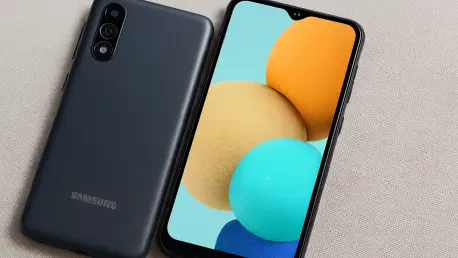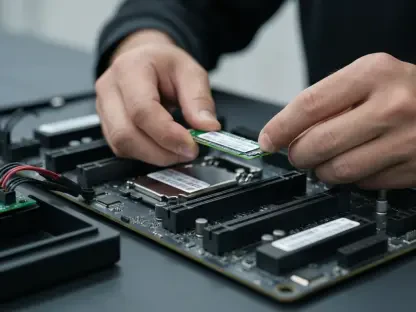In a world where smartphone prices often soar into the thousands, finding a device that balances affordability with reliable performance remains a significant challenge for millions of users globally. Imagine a student in a developing market needing a phone for online classes, or a first-time buyer seeking durability without breaking the bank—scenarios like these highlight the critical demand for budget-friendly technology. This review dives into a device crafted for such needs, exploring how it aims to redefine value in the entry-level segment with meaningful upgrades and long-term support.
Key Specifications at a Glance
Delving into the core of this budget contender, the smartphone features a MediaTek Helio G99 chipset, a notable leap from older processors in its class. Built on a 6nm process, this chip integrates Cortex-A76 CPU cores and a Mali-G57 MC2 GPU, delivering enhanced performance and power efficiency for everyday tasks. Compared to previous entry-level offerings, this hardware ensures smoother navigation through apps and improved multitasking capabilities.
The device sports a 6.7-inch LCD display with a 90Hz refresh rate, providing a fluid visual experience despite sticking to a 720p+ resolution. Camera-wise, it offers an 8MP front sensor for basic selfies and a 50MP rear camera accompanied by a 2MP depth sensor, adequate for casual photography. These specifications position the phone as a practical choice for users prioritizing functionality over high-end imaging.
Rounding out the essentials, a 5,000mAh battery with 25W fast charging promises enduring power and quick replenishment. Connectivity includes dual-SIM 4G, Wi-Fi 5, Bluetooth 5.3, USB-C 2.0, a microSD slot for expandable storage, and a 3.5mm headphone jack—a rarity in modern designs. Physically, its slim 7.6mm profile and 184g weight make it comfortable for prolonged use.
Performance and Usability
Focusing on real-world performance, the MediaTek Helio G99 chipset shines in handling routine activities like browsing social media, streaming videos, and managing light productivity apps. Users will notice a marked improvement in responsiveness compared to older budget models, with minimal lag during app transitions. This makes the device a reliable companion for those who need consistent operation without premium overheads.
Energy efficiency is another strong suit, as the 6nm architecture of the processor reduces power consumption, complementing the large battery capacity. Whether it’s a long day of messaging or video calls, the phone holds up admirably under typical usage. This balance of power and endurance caters well to cost-conscious demographics such as students or workers in emerging markets.
However, limitations surface in more demanding scenarios like gaming or heavy multitasking, where the hardware shows its entry-level constraints. Graphics-intensive applications may experience occasional stutters, reminding users of the phone’s budget roots. Still, for its intended audience, the performance aligns well with expectations of basic to moderate use.
Software and Longevity Features
A standout aspect of this smartphone lies in its software commitment, launching with Android 15 and a customized user interface that enhances navigation. Samsung pledges six OS updates, an exceptional promise for a budget device, ensuring it stays current with features and security patches from now through at least 2031. This focus on longevity addresses a common pain point in affordable segments—rapid obsolescence.
Durability also gets a boost with an IP54 rating, offering protection against dust and minor water splashes. This addition, absent in many competitors at this price point, provides peace of mind for users in unpredictable environments, from dusty streets to sudden rain. Such practical enhancements elevate the device’s appeal for everyday reliability.
The combination of extended software support and physical resilience sets a new benchmark for entry-level phones. It reflects a shift in manufacturer priorities toward sustaining value over time, ensuring the device remains functional and secure well beyond the typical lifecycle of budget models. This approach particularly benefits users wary of frequent upgrades due to cost constraints.
Target Market and Practical Applications
Designed with specific demographics in mind, this smartphone targets budget-conscious individuals, including first-time buyers, students, and residents of regions without widespread 5G infrastructure. Its feature set aligns with essential needs like communication via messaging apps, accessing educational content, and engaging with social platforms. For instance, a young user can rely on it for virtual learning without worrying about quick battery drain.
In markets where affordability trumps cutting-edge tech, the device’s 4G connectivity and expandable storage via microSD cater to local preferences for cost-effective data solutions. The inclusion of a headphone jack further appeals to those who value traditional audio options over wireless alternatives. Such thoughtful inclusions make it a fitting tool for diverse, price-sensitive audiences.
Beyond individual use, it serves as an ideal secondary phone for travelers or professionals needing a backup without premium costs. Its lightweight build and robust battery support on-the-go functionality, whether for navigation or emergency contact. This versatility underscores its role as a practical, no-frills option in a crowded market.
Competitive Challenges and Limitations
Despite its strengths, the device faces hurdles in a fiercely competitive budget segment. The absence of 5G connectivity limits its future-proofing in regions rapidly adopting next-gen networks, potentially alienating users looking for longer-term investments. This gap could steer some toward rival brands offering 5G at similar price points.
Display quality, while smooth with a 90Hz refresh rate, falls short of mid-range standards due to its lower resolution, impacting clarity in detailed content like high-definition videos. Camera performance also underwhelms in low-light conditions, with the 50MP sensor struggling to capture sharp images without ideal lighting. These drawbacks highlight trade-offs inherent in keeping costs low.
Regional pricing variations add another layer of complexity, with configurations ranging from roughly $85 to $140 depending on market and storage options. While accessible, these fluctuations and competition from other affordable brands challenge Samsung’s dominance in certain areas. Balancing value with innovation remains a critical task for maintaining market share.
Outlook for Budget Smartphone Evolution
Looking ahead, the trajectory for Samsung’s entry-level lineup suggests a continued emphasis on incremental improvements rather than revolutionary changes. A potential 5G variant of this model could emerge in coming years, addressing connectivity gaps and aligning with global network trends. Such a move would strengthen its position against competitors already offering next-gen support.
Extended software updates are likely to become a hallmark of future budget devices, as manufacturers recognize the importance of longevity for consumer trust. Hardware upgrades, particularly in display resolution and camera tech, might also trickle down to affordable tiers, narrowing the gap with mid-range offerings. This gradual enhancement strategy seems poised to define the segment.
Samsung’s focus on durability features like dust and water resistance could inspire broader industry standards for entry-level phones. As cost-conscious markets grow, balancing affordability with meaningful innovation will be key to capturing loyalty. The evolution of this series will likely hinge on adapting to regional needs while pushing the boundaries of what budget devices can achieve.
Final Reflections
Reflecting on the evaluation, the assessment of this budget smartphone revealed a device that punched above its weight with a capable chipset, enduring software support, and practical design choices. It carved a niche for itself by addressing core user needs without unnecessary frills, proving that affordability need not equate to compromise. The commitment to six years of updates stood out as a game-changer in its category.
For those considering a purchase, exploring local configurations and pricing proved essential, as variations offered flexibility for different budgets. Potential buyers were encouraged to weigh the lack of 5G against immediate needs, especially in areas where 4G remained dominant. Looking forward, keeping an eye on Samsung’s next moves in this lineup offered a chance to anticipate even better value in upcoming iterations.









